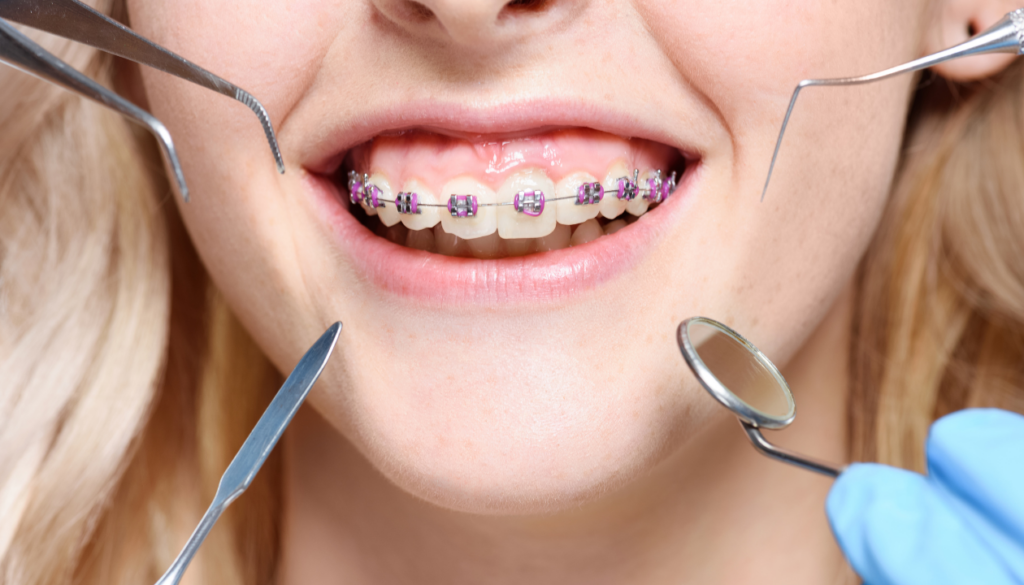Choosing the right braces can feel overwhelming, especially with so many options available. Metal braces and clear braces each have their pros and cons, making it essential to understand what suits your lifestyle and dental needs best.
Whether you’re a teenager looking for a trendy option or an adult seeking a discreet solution, knowing the differences can help you make an informed decision.
Metal braces are often the go-to choice for their durability and effectiveness in treating complex dental issues. On the other hand, clear braces offer a more subtle appearance, appealing to those who prefer a less noticeable treatment.
Let’s dive into the details of both options to help you find the perfect fit for your smile journey.
Overview of Metal Braces and Clear Braces
Metal braces consist of high-grade stainless steel brackets and wires. They utilize the tension within the wire to gradually move teeth into the desired position. Metal braces excel in treating various alignment issues and offer a cost-effective solution.
They’re suitable for all ages and often recommended for complex cases.
Clear braces, also known as ceramic braces, feature clear or tooth-colored brackets. They provide a more aesthetic option while still utilizing traditional orthodontic techniques. Clear braces blend with your teeth, making them less noticeable.
They’re ideal for individuals seeking a discreet treatment option, though they might be less effective for severe adjustments.
Metal and clear braces each present unique benefits. Your choice hinges on personal preference, treatment needs, and lifestyle considerations. Understanding these distinctions plays a vital role in making an informed decision for your orthodontic journey.
Key Differences Between Metal and Clear Braces
Understanding the key differences between metal and clear braces helps you make an informed choice. Each type offers unique benefits and considerations.
Aesthetics and Visibility
Metal braces are noticeable due to their shiny, metallic appearance. They often stand out against teeth, which can impact self-image, especially for adults.
Clear braces provide a more discreet alternative, featuring transparent or tooth-colored brackets that blend with natural teeth. This option appeals to those concerned about aesthetics.
However, their visibility can still be noticeable up close, and they may attract stains if not properly cared for.
Material Composition
Metal braces are typically made from high-grade stainless steel, ensuring durability and strength. This material withstands significant pressure, crucial for correcting severe misalignments.
Clear braces, or ceramic braces, utilize materials that mimic tooth color. Though less visible, ceramic brackets are more fragile than metal ones. They may chip or break more easily, requiring careful handling and maintenance.
Treatment Duration
Treatment duration often varies between the two types of braces. Metal braces generally yield faster results, particularly for complex dental issues, as their robust design allows for efficient movement of teeth.
Clear braces may take longer to achieve similar results, especially in severe cases, due to their construction’s limitations. On average, metal braces offer treatment timelines of 18 to 24 months, while clear braces can extend treatment to 24 to 36 months, depending on individual cases.
Pros and Cons of Metal Braces
Metal braces are a popular choice for many orthodontic patients. They offer specific benefits and drawbacks that you should consider before making your decision.
Advantages of Metal Braces
- Durability: Metal braces are constructed from high-grade stainless steel, making them highly durable and resistant to breakage.
- Effectiveness: Metal braces efficiently address complex dental issues, making them suitable for all ages and often recommended for severe alignment problems.
- Faster Treatment Times: Studies indicate that metal braces typically achieve desired results in a shorter time frame compared to clear braces.
- Cost-Effective: Metal braces often come at a lower price point than clear options, making them more accessible for various budget ranges.
- Versatility: Metal braces can effectively handle a wide range of orthodontic cases, accommodating different treatment needs.
Disadvantages of Metal Braces
- Visibility: Metal braces are more noticeable than clear braces, which may affect your self-esteem, especially in social situations.
- Oral Hygiene Challenges: Cleaning around brackets and wires can be difficult, potentially increasing the risk of plaque buildup and cavities.
- Discomfort: You may experience some discomfort after adjustments as metal braces apply continuous pressure to your teeth.
- Diet Restrictions: Certain foods, like hard candies and popcorn, should be avoided to prevent damage to the braces.
- Potential for Irritation: Metal brackets and wires can cause irritation to the inside of your cheeks and lips, leading to discomfort.
Understanding the pros and cons of metal braces helps you make an informed choice that aligns with your dental needs and lifestyle.
Pros and Cons of Clear Braces
Clear braces offer specific benefits and drawbacks that you should consider when deciding on your orthodontic treatment. Understanding these factors helps in evaluating whether clear braces meet your dental needs.
Advantages of Clear Braces
- Aesthetic Appeal: Clear braces blend with your natural teeth, providing a more discreet option than traditional metal braces.
- Comfort: Clear brackets often feature a smoother surface, minimizing irritation to your gums and cheeks during treatment.
- Maintenance: Clear braces typically require the same care as metal braces, but they may resist staining better when properly maintained.
- Customization: Some clear braces can be tailored to match your tooth color, enhancing the inconspicuousness of the treatment.
- Fewer Emergency Visits: Clear braces may reduce the likelihood of broken brackets, requiring fewer emergency visits for repairs.
Disadvantages of Clear Braces
- Less Durability: Clear braces use ceramic material, which can be more susceptible to breaking than metal alternatives.
- Staining Risk: Your clear brackets might stain if you consume certain foods or beverages, potentially impacting their appearance over time.
- Treatment Duration: Clear braces often involve a longer treatment process compared to metal braces, as they might not move teeth as efficiently.
- Cost: Generally, clear braces come with a higher price tag than metal braces, which can influence your decision based on budget.
- Size and Weight: Clear brackets may be bulkier than metal ones, potentially causing some discomfort during the adjustment period.
Factors to Consider When Choosing
Choosing between metal braces and clear braces involves multiple factors tailored to your unique situation. Understanding these aspects aids in making the best decision for your orthodontic treatment.
Dental Condition and Needs
Your dental condition significantly influences the choice between braces. Metal braces effectively address severe alignment issues and complex cases, providing reliable results.
If your orthodontic needs include significant corrections, metal braces may serve you better. Clear braces excel in cases requiring minor adjustments, but they may not deliver the same efficiency for complex situations.
Consulting with an orthodontist ensures an evaluation of your specific dental condition to determine the most suitable option.
Lifestyle and Personal Preferences
Your lifestyle and personal preferences play a pivotal role in the decision-making process. If you prioritize discretion and aesthetic appeal, clear braces might be the optimal choice for you.
These braces offer a less noticeable appearance, making them ideal for social situations or professional environments. On the other hand, if you engage in contact sports or prefer a robust solution, metal braces provide the durability and resilience you might require.
Considering your daily activities and comfort levels helps you select the right orthodontic treatment.
Cost Considerations
Cost remains an essential factor when choosing between metal and clear braces. Metal braces generally come with a lower overall price tag, often making them a more budget-friendly option.
Clear braces typically involve higher costs due to specialized materials and aesthetics. Insurance coverage may also vary for each type, affecting your out-of-pocket expenses.
Performing a cost-benefit analysis ensures you balance your financial considerations with your dental needs, aiding in a well-informed decision.
Conclusion
Choosing between metal braces and clear braces ultimately depends on your unique needs and preferences. If you prioritize durability and effectiveness for complex dental issues metal braces might be the right choice. They offer a proven track record and often result in quicker treatment times.
On the other hand if aesthetics and comfort are more important to you clear braces can provide a more discreet option. They are ideal for those who want to maintain a natural look during their treatment.
Consider factors like your lifestyle budget and dental condition as you make your decision. Whichever option you choose make sure it aligns with your goals for a healthier and more confident smile.
Frequently Asked Questions
What are the main differences between metal and clear braces?
Metal braces are made from high-grade stainless steel and are generally more durable and effective for severe dental issues. Clear braces, or ceramic braces, use clear or tooth-colored materials for a discreet look but may not be as effective for complex cases.
How much do metal and clear braces cost?
Metal braces usually cost less than clear braces. The price varies based on treatment complexity and location, but metal braces are typically more budget-friendly, making them a popular choice.
Are clear braces less painful than metal braces?
Pain levels can vary by individual, but after adjustments, metal braces may cause discomfort for a few days. Clear braces might feel more comfortable initially, but discomfort can still occur if adjustments are needed.
How long does treatment take with metal vs. clear braces?
Generally, metal braces offer quicker treatment times due to their effectiveness in severe cases. Clear braces may take longer to achieve similar results, especially for more significant adjustments.
Can I eat normally with metal and clear braces?
With both types, you should avoid hard, sticky, or chewy foods. Metal braces may cause more dietary restrictions due to their structure, while clear braces are more susceptible to staining from certain foods and drinks.
How do I maintain my braces?
Both metal and clear braces require proper oral hygiene. Brush teeth at least twice daily, floss regularly, and consider using orthodontic wax for irritation. Follow your orthodontist’s specific care instructions for optimal results.
Are there any aesthetic options for metal braces?
Yes, metal braces can come with colored elastics, allowing for some customization. However, they will still be more visible than clear braces, making them less appealing for those prioritizing aesthetics.
Can I play sports with metal or clear braces?
Yes, you can play sports with either type, but it’s essential to wear a protective mouthguard, especially with metal braces, to avoid injury and ensure safety during contact activities.
Find the Right Braces for Your Teen at McCarty Orthodontics—Schedule a Consultation Today!
Choosing between metal braces and clear braces for your teen can be tough, but McCarty Orthodontics is here to help. Our expert team will guide you through the pros and cons of each option, ensuring the best fit for your teen’s lifestyle and orthodontic needs.
Book a consultation today to explore your options and give your teen the gift of a confident smile!


